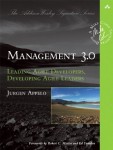Today I counted no less than four new initiatives promoted by our employees: A business…

Really, Can You Be Agile and Not Disciplined?
Sometimes people tell me, “Wow, you’re so disciplined!” And then I think, “How do you stay sane when you’re not?”
Last week, it happened again. On Facebook I posted a screenshot of the huge checklist that I use as a quality assurance gate for my book chapters. Some people commented that this looked quite disciplined.
Frankly speaking, I don’t see what’s so special about my discipline. If you want to be agile you have to be disciplined!
I don’t see how it can be any different.
Agility versus Discipline
Ever since Barry Boehm published his badly titled book Balancing Agility and Discipline, people have offered different views on the discipline issue in Agile communities. Scott Ambler offers his Disciplined Agile Delivery—apparently taking the stance that others are offering undisciplined versions of it—while dozens of other writers consider the statement “agile is undisciplined” to be one of the many myths of Agile.
Probably, all of them have good points.
Check the work processes of a dozen Scrum teams and I bet you will find that most Scrum teams do not have a properly defined Definition of Done. That would be comparable to me writing a book without a checklist. Amazing! I wouldn’t even dare to send my chapters to copy editors or proof readers without at least some form of quality assurance.
Apparently, in software teams this view is uncommon.
Agility Needs Discipline
You’d be amazed to hear about the number of things I changed in the two years that I’ve been writing my book. Should quotations have the author’s full names or only their last names? Do I refer to knowledge workers or creative networkers? Does the chapter have an opening summary? Am I talking about managers or management? Do I refer to illustrations with a word or with an icon? Do I use l: or to loc: in the references to ebook locations? Does the page footer have the book title or the URL?
These decisions, and many more, have all changed in the last two years. Yes, I change my mind all the time because of new insights and experiences. And that’s fine. Responding to change is good. It is one of the core principles of being Agile.
I respond to change by updating my checklists. For example, when I decided halfway through the project that I wanted tweetable statements in my chapters (which are clearly marked in a special format) I added a new checklist item that required me to revisit the earlier chapters, which didn’t yet have that feature. Shall we remove US states from the bibliography? Add a checklist item. Am I using capitalized Agile inconsistently? No problem, let’s add a checklist item.
I don’t see how else I can be agile as a writer.
I would go insane without my checklists, or else I would not dare change anything.
Agility Thanks to Discipline
Last week, I asked someone to check his personal story, which I had included in one of my new book chapters. He replied, “Wow, I sent you that story two years ago. I’m amazed you still remember!” Well, to be honest, I don’t have a memory that good. What I have is discipline.
I have folders in Gmail and in Evernote where I dump the stories and notes that people send me, and I tag all data with keywords. I also have a checklist item for each chapter requiring me to “add stories from Gmail and Evernote” which I must do before the chapter goes to the copy editors. I have another checklist item telling me to “confirm edited stories with their authors” which must be checked after the chapter comes back from the copy editors and before it goes to the proof readers. Indeed, the personal stories feature is also an idea that emerged very late in the book project. No problem! Now all chapters have stories.
Seriously, I don’t see how I could produce a quality book, in an Agile way, without my checklists.
By now I’m used to people calling me “disciplined”, but each time I (gladly) receive this compliment, I secretly think, “You mean, you’re not? How do you stay sane?”
 Are you curious to know what managers can do in an Agile organization?
Are you curious to know what managers can do in an Agile organization?
Get the book!
Management 3.0
Leading Agile Developers, Developing Agile Leaders



